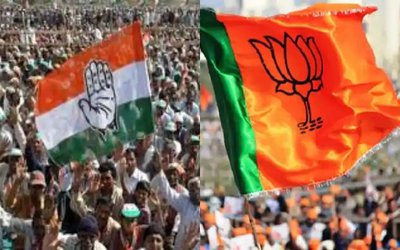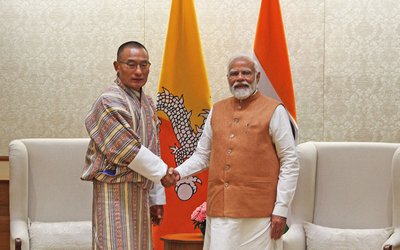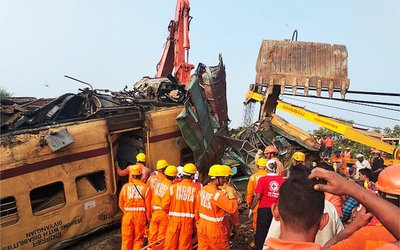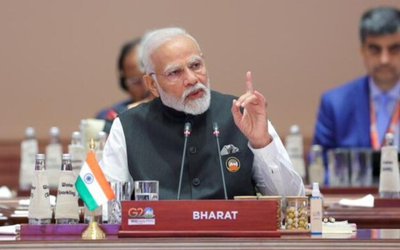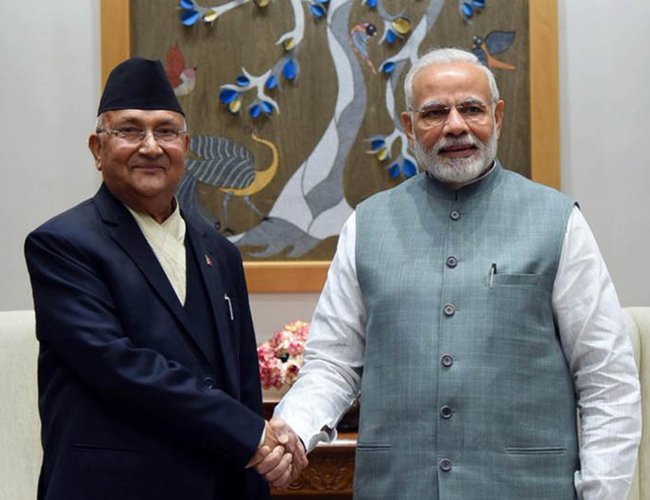
On May 8, India’s defence minister virtually inaugurated a new 80 km-long road in the Himalayas, connecting to the border with China, at the Lipulekh pass. The Nepali government protested immediately, contending that the road crosses territory that it claims and accusing India of changing the status quo without diplomatic consultations.
Over one month later, the bilateral crisis seems to now be stuck in a stalemate, a worrisome trend in otherwise friendly India-Nepal relations. I try to answer some of the key questions on the crisis, the possible factors that escalated the dispute, the geostrategic context, and ways to de-escalate towards a solution.
Why did India build this road through territory claimed by Nepal?
India has been in effective possession of this territory for at least sixty years, although Nepal claims it conducted a census there in the early 1950s and refers to the 1815 Sugauli Treaty as legitimising its claims. But India’s new road, up to the Lipulekh pass, is not an unprecedented change in the status quo. India has controlled this territory and built other infrastructure here before, besides conducting its administration and deploying military forces up to the border pass with China.
The region is of strategic importance, and the new road is now one of the quickest links between Delhi and the Tibetan plateau. In a 2015 statement, China also recognised India’s sovereignty by agreeing to expand trade through the Lipulekh pass. Finally, this is also an important route for thousands of Hindus who trek across the border with China every year to visit the sacred Mount Kailash. Given recurrent military tensions with China, the future potential of trade, and the religious symbolism of the region, India will certainly continue to exercise civilian and military contro
Is there any reason for the timing of the Indian announcement on May 8?
Nepal may not even have figured in India’s decision to time the announcement on May 8. Unless part of a larger signaling game directed at China, the Indian defence minister was probably more interested in scoring a domestic success by bringing good news during the lockdown period. Even if warned about the negative repercussions this could have on relations with Nepal, Indian decisionmakers clearly did not factor this in. From the perspective of maintaining good India-Nepal relations, any other timing would have been better than May 8.
Why has this border dispute become so politically charged in Nepal?
In line with democratisation and competitive nationalism, Nepal’s foreign policy is becoming increasingly politicised. The Indian road was not built overnight and the Nepal government was surely aware and monitoring the situation in Kalapani over the preceding months and years. The issue had come up in November last year, when India announced its new political map, after the revocation of Article 370: as for many decades before, the Indian map continued to include territories claimed by Nepal, but this time the government in Kathmandu took it up officially and publically. It also became a popular issue in Nepal, with the hashtag #BackOffIndia trending on social media.
For the beleaguered Nepali prime minister, India’s May 8 announcement thus fell like a gift from heaven as he faced his worst internal crisis since coming to power, in 2017. He was swiftly able to mobilise public opinion, play up nationalist sentiments against India, get his internal party rivals on board, and divert attention from his failed ordinances and challenges to contain the pandemic.
Are domestic politics hindering Nepal’s foreign policy?
Nepal has one of the world’s youngest populations and, especially after India’s implicit support for the 2015 blockade on the landlocked country, anti-Indian sentiments have been running high. This offers a new generation of Nepali politicians a powerful fuel to mobilise the electorate.
Did China engineer this border dispute between India and Nepal?
No, the border dispute between India and Nepal was brewing for many months and years, so it is unreasonable to blame China for creating the crisis. The counter-factual is clear: even if we hypothetically imagined China away, Prime Minister Oli and Nepali nationalists would always have reacted negatively to the Indian road announcement. For many years, Delhi was well aware that the issue was prone to politicisation in Nepal.
All this does not mean that Beijing has not supported or further instigated Kathmandu to take on a more assertive position, especially against the backdrop of the China-India military standoff in Ladakh. This could have contributed to the severity of the India-Nepal crisis. But we simply don’t know enough about the China factor, and it is thus simplistic, if not outright harmful to call Prime Minister Oli’s government “pro-China” or reflexively “anti-India” because of his party’s communist credentials.
Is China’s political influence in Nepal harming Indian interests?
We know from other recent crises in the region, for example in the Maldives in the aftermath of the 2017-18 Doklam crisis, that China rarely shies away from an opportunity to use India’s neighbours as proxies, especially when its relations with Delhi are tense. Nepal and several other Indian neighbours are young democracies, developing new institutions in a political transition that can be instable, as we see in Myanmar. But Beijing’s authoritarian system and appeal is growing and may hinder further democratisation, undermine the rule of law, or curtail critical media and academic independence.
India has always seen a more democratic Nepal as being in its interest, leading to greater stability and inclusiveness, especially towards minorities in the Madhes. In 2006, after returning his ambassadorial post in Kathmandu, then Foreign Secretary Shyam Saran emphasised that “stability in Nepal is in the best interests of India” and that “democracy in Nepal is the best guarantee of such stability.”
As China’s political influence grows in Nepal, Beijing may have, at least indirectly, encouraged Prime Minister Oli to take a bolder stance against India during the current crisis. Recent examples show how China reportedly mediated between different factions to keep the CPN in power, how it put pressure on critical reporting in the Nepali media, and how it promoted the authoritarian governance model of China’s Communist Party. But often it is also Nepali’s self-censorship and over caution that has the greatest effect, seeking to please China even when Beijing doesn’t really care that much and defers to Delhi.
By playing the China balancing card as a last resort, Nepali leaders often hope to get Delhi to pay attention to festering problems that Indian diplomacy neglects or forgets about. This is a risky game because it raises alarm bells in Delhi, especially in the security and strategic establishments, which are quick to step in and tend to resort to coercive tools that can further escalate the dispute. It is also risky because it assumes China is always willing to extend indefinite support to Nepal at the cost of its relations with India.
Does this dispute reflect a deeper problem in India-Nepal relations?
The rising presence of China across the Himalayas, especially after the BRI, forced India to recalibrate its policy towards Nepal. Delhi has begun shifting the emphasis away from geostrategic denial and insulation towards greater economic delivery and connectivity. This has been a tough adjustment, beginning in the 2000s, but with many Indian actors pushing in different directions. Some in India still look at twenty-first century Nepal through a nineteenth century colonial prism: as a buffer state with limited sovereignty, where India’s resources should be focused on political engineering and cultivate assets to topple a pro-China “puppet government.”
There is no better example of the larger problem in India-Nepal relations than the tragic fate of the report prepared by the Eminent Persons Group (EPG) from both countries. The EPG was mandated in 2015 by Prime Minister Modi and former Nepali Prime Minister Deuba to assess the state of bilateral relations and come up with major recommendations, whether on the 1950 Treaty or the open border.
Submitted in 2018, the EPG report has still not been accepted: sources initially noted that Prime Minister Modi had not found the time, but by now it is obvious that Delhi is uncomfortable with some of the non-binding, expert recommendations that it had commissioned itself. Such lack of confidence and openness to reassess the fundamentals of the relationship has transmitted negative signals to Nepal.
Does this crisis reflect a failure of India’s Neighbourhood First policy?
No, it is rather simplistic to assume that this crisis reflects a failure of India’s regional strategy. On Nepal, in particular, the successes have been astonishing since the 2015 course correction, after the blockade. After 2017, in particular, Prime Ministers Modi and Oli engaged at the highest level on multiple occasions and developed a direct, political and personal link that India-Nepal relations were often lacking, maybe since the 1980s.
Most importantly, driven by a new logic of interdependence and connectivity, India invested in upgrading its cross-border infrastructure and economic assistance: there are now new rail and road links, an electronic cargo system for Nepali goods to transit via Indian ports, inland waterway navigation plans, and a new cross-border pipeline for petroleum products. These are just some examples of the many achievements of India’s new connectivity strategy, focused on delivering more, better and faster to support the development objectives of Nepal and other neighbours. Unfortunately, these silent successes rarely make it to the headlines in Delhi or Kathmandu.
It is important for Delhi to realise that Kathmandu politics matters, but that different governments will come and go, all proclaiming an “India first” policy even while balancing with Beijing and others. India will continue to have its friendly political preferences in Nepal, but it should never forget that only its interests are permanent.
Why has India not yet taken the initiative to defuse tensions and begin a diplomatic dialogue?
India’s silence is the greatest cause for concern for the future of bilateral relations and is creating natural uneasiness in Kathmandu. After indirectly indicating its displeasure at the politically charged environment in Nepal, India has largely remained silent. The optics of the Indian ambassador in Kathmandu being summoned also conveyed India’s discontentment: the envoy simply “stated” Delhi’s position and handed over a public declaration of the MEA’s spokesperson.
One month later, we have still not seen any significant de-escalatory move from Delhi, and that betrays clear intent, especially in a context of friendly relations marked by a positive phone call between both leaders in early April. Silence speaks volumes and the relationship may now be in for a deep freeze. We do not know the exact reasons why, but it certainly transpires that Delhi does not feel comfortable to address the issue at this point or in the current context.
Does this mean India has lost confidence in Prime Minister Oli?
It is possible that this affected Delhi’s trust in Prime Minister Oli, especially given how long this dispute has played out and that both leaders have still not talked to each other. Whether it is because of his relations with China, his politicisation of the dispute, his jibes at India’s national symbols, or any other possible reason, it certainly looks like Delhi may now be less confident in Prime Minister Oli. This does not mean India will interfere to support any political alternative, despite what may circulate in Kathmandu’s many conspiracy corridors.
The reality, once again, is less flattering. Delhi may simply not care, having made its displeasure clear and now willing to wait it out. This would mean that India may now see Prime Minister Oli as more of a problem, rather than part of the solution to improve bilateral relations.
Are both sides really interested in a dialogue?
Not necessarily. Nepali analysts often overestimate the importance of their country in India’s foreign and security policies, or read too much into its allegedly “strategic” outlook. Not everything is planned in detail: Delhi’s decisionmaking, even on next-door Nepal, can be quite confusing and contingent. With many other urgent issues taking precedence in India, whether the COVID-19 pandemic at home or the military standoff with China, Nepal may simply not be a priority.
India’s calculation may be that it can afford to wait this out, watching how Kathmandu’s politics play out.
Will India ever give up control over the territory claimed by Nepal?
Unlikely and certainly not under any compulsion. Nepali nationalists may like to believe that passing a constitutional amendment, roping in the support of China or internationalising the issue at the United Nations will force India to back down. But it is doubtful that any realist in Kathmandu, especially Prime Minister Oli, is under the illusion that Delhi will cave in to any such demands or coercion. This is why despite all of its political rhetoric and pressure, the Nepali government has always continued to emphasise the importance of a diplomatic dialogue.
Are there any possible solutions to this dispute in the long term?
The sooner India settles this dispute with Nepal, the lesser the chances for China to get involved. Beijing has chosen to remain quiet this time, but its future calculation may change. The Kalapani dispute between India and Nepal is also an almost perfect mirror case of the 2017 Doklam crisis between China and Bhutan, where India stepped up and deployed its military forces to restore the status quo ante.
Hostile states have been able to find such innovative solutions in other parts of the world and, at one point, India and Pakistan were close to finding solutions for Siachen or to make borders irrelevant in Kashmir. Based on their history of friendly relations and driven by pragmatism, it should not be difficult for India and Nepal to think out of the box and find a practical solution. Delhi and Kathmandu could lead the way to liberate the subcontinent from the sovereignist, nationalist and territorial logic that continues to leave everyone in the region worse off.
Constantino Xavier is a Fellow in Foreign Policy Studies at Brookings India in New Delhi and the Brookings Institution in Washington DC. Views are personal.
The article was first published on the Brookings website.




